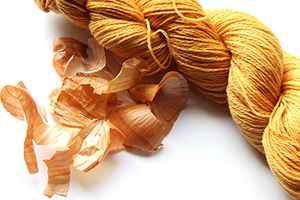Onion Skins

Onion Skins
Onion "skin" dye has been used for egg and cloth coloring for many years in Persia, also in the Middle East and Europe. During the spring holiday (Novruz) in Perisa, onion skins are used to dye the eggs for decorating the hon cha - a tray with sweets, nuts fruits, and dyed eggs on. Samani always is the dominant feature. This is one of a few ancient traditions which is preserved until today.
Onion skins were also used for hair lightening as well as saffron and chamomile tea. It is a well-known historical fact that the onion was grown extensively by the ancient Egyptians.
Onion Skin Dye
Onion skin dyes provide a broad range of colors. Onion skins do not require mordanting to adhere to the wool, but mordants are used to get different shades. Depending on the mordant used, yellow-skinned onions will yield burnt and bright orange, yellow, brass, and brown colors, while red-skinned onions will yield reddish-orange, pink, salmon, gold, tan-brown, and dark tan dyes. Onion skins will produce a beautiful orange color with alum. White vinegar can be used for acidity. It must be noted that dyeing should be done in a non-reactive (non-aluminum) pot that is used exclusively for dyeing.
